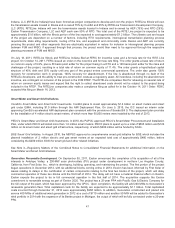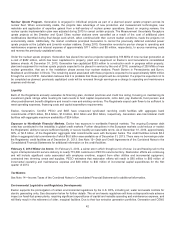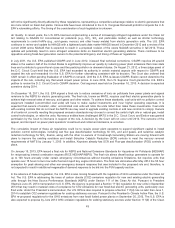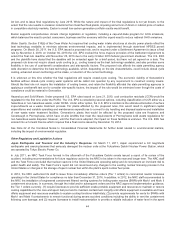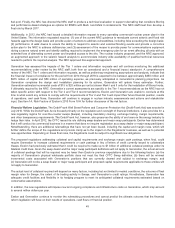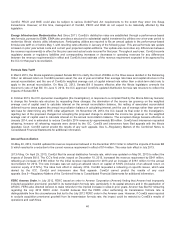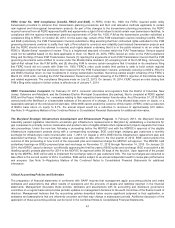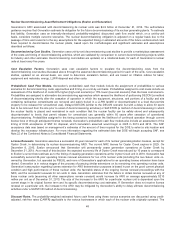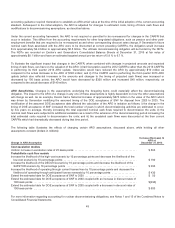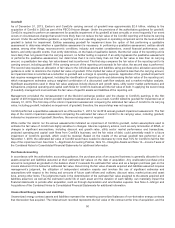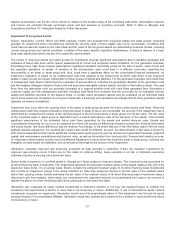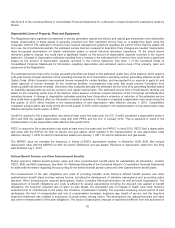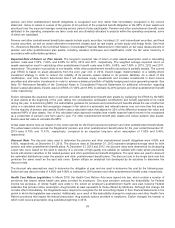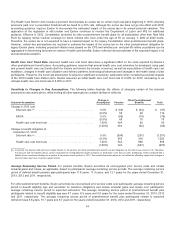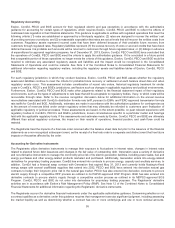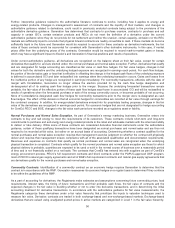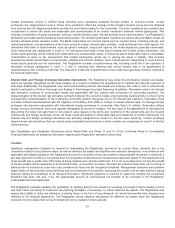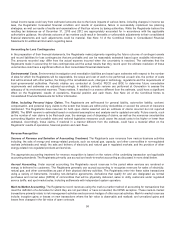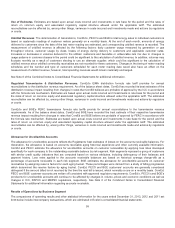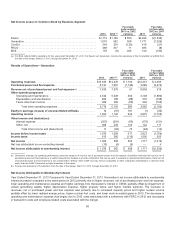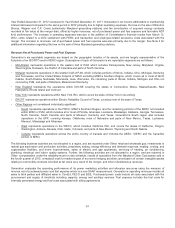ComEd 2013 Annual Report Download - page 57
Download and view the complete annual report
Please find page 57 of the 2013 ComEd annual report below. You can navigate through the pages in the report by either clicking on the pages listed below, or by using the keyword search tool below to find specific information within the annual report.balanceis amortizedover thelifeofthecontractin relation to the present value oftheunderlyingcash flows. Amortization expense
andincome are recordedthrough purchasedpower andfuel expense or operatingrevenues. Refer to Note 4—Mergersand
AcquisitionsandNote 10—Intangible Assetsfor further discussion.
Impairment of Long-lived Assets
Exelon,Generation,ComEd, PECO and BGE regularlymonitor andevaluate their long-livedassetsandasset groups, excluding
goodwill,for impairment when circumstancesindicate thecarryingvalue ofthoseassetsmaynot berecoverable.Conditionsthat
couldhaveanadverseimpactonthecash flows andfairvalue ofthe long-livedassetsare deterioratingbusiness climate,including
current energy pricesandmarket conditions, condition oftheasset,specific regulatory disallowance,or plansto disposeofa long-
livedasset significantlybefore theendofitsuseful life,amongothers.
Thereviewoflong-livedassetsandasset groupsfor impairment requires significant assumptionsabout operatingstrategiesand
estimatesoffuture cash flows, which require assessmentsofcurrent andprojectedmarket conditions. For thegeneration business,
forecastingfuture cash flows requiresassumptionsregardingforecastedcommoditypricesfor thesale ofpower,costsoffuel and
theexpectedoperationsofassets. Avariation intheassumptionsusedcouldleadto a different conclusion regardingthe
recoverabilityofan asset or asset group and, thus, couldhaveasignificant effectontheconsolidatedfinancial statements. An
impairment evaluation is basedon an undiscountedcash flowanalysis at thelowestlevel at which cash flows ofthe long-lived
assetsor asset groupsare largelyindependent ofother groupsofassetsandliabilities. For thegeneration business, thelowestlevel
ofindependent cash flows is determinedbyevaluation ofseveral factors, includingthegeographic dispatch ofthegeneration units
andthehedgingstrategiesrelatedto thoseunitsandassociatedintangible contractassetsrecordedon thebalancesheet.Thecash
flows fromthegeneration unitsare generallyevaluatedat a regional portfoliolevel withcash flows generatedfromGeneration’s
customer supplyandrisk management activities, includingcash flows fromcontractsthat are accountedfor asintangible contract
assetsandliabilitiesrecordedon thebalancesheet.Incertaincasesgeneration assetsmaybeevaluatedon an individual basis
where thoseassetsare contractedon a long-termbasis withathirdpartyandoperationsare independent ofother generation assets
(typicallycontractedrenewables).
Impairment mayoccur when thecarryingvalue oftheasset or asset group exceeds thefuture undiscountedcash flows. When the
undiscountedcash flowanalysis indicatesa long-livedasset or asset group is not recoverable,theamount oftheimpairment loss is
determinedbymeasuringtheexcess ofthecarryingamount ofthe long-livedasset or asset group over itsfairvalue.Thefairvalue
ofthe long-livedasset or asset group is dependent upon a market participant’s viewoftheexitpriceoftheassets. This includes
significant assumptionsoftheestimatedfuture cash flows generatedbytheassetsandmarket discount rates. Eventsand
circumstancesfrequentlydo not occur asexpectedandthere will usuallybedifferencesbetween prospectivefinancial information
andactual results, andthosedifferencesmaybematerial.Accordingly, to theextent that anyoftheinformation usedinthefairvalue
analysis requiresadjustment,theresultingfairmarket value wouldbedifferent.Assuch, thedetermination offairvalue is driven by
bothinternal assumptionsthat includesignificant unobservable inputs(Level 3)such asrevenue andgeneration forecasts, projected
capital,andmaintenanceexpendituresand discount rates, aswell asinformation fromvariouspublic, financial andindustrysources.
An impairment determination wouldrequire theaffectedRegistrant to reduceeither the long-livedasset or asset group,includingany
intangible contractassetsandliabilities, andcurrent periodearnings by theamount oftheimpairment.
Generation evaluatesunprovedgasproducingpropertiesat least annuallyto determine if theyare impaired. Impairment for
unprovedgaspropertyoccursifthere are no firmplansto continue drilling, leaseexpiration is at risk, or historical experience
indicatesadecline incarryingvalue belowfairvalue.
Exelon holds investmentsincoal-firedplantsinGeorgiaandTexassubject to long-termleases. Theinvestmentsare accountedfor
asdirectfinancingleaseinvestments. Theinvestmentsrepresent theestimatedresidual valuesofthe leasedassetsat theendofthe
respective lease terms. On an annual basis, Exelon reviews theestimatedresidual valuesofitsdirectfinancingleaseinvestments
andrecords an impairment chargeif thereviewindicatesan other than temporarydecline inthefairvalue oftheresidual values
belowtheircarryingvalues. Exelon estimatesthefairvalue oftheresidual valuesofitsdirectfinancingleaseinvestmentsusinga
discountedcash flowanalysis, which takesinto consideration theexpectedrevenuesto begeneratedandcoststo beincurredto
operate the plantsover theirremaininguseful livessubsequent to the leaseenddates.
Generation alsoevaluatesitsequitymethodinvestmentsto determine whether or not theyare impairedbasedon whether the
investment hasexperiencedadecline invalue that is not temporaryin nature.Additionally, if one ofGeneration’s equitymethod
investmentsrecognizeanimpairment,Generation wouldrecorditsproportionate share ofthat impairment loss through itsequity
earnings (losses) ofunconsolidatedaffiliates. Generation wouldalsoevaluate theinvestment for a decline invalue at that timethat is
not temporaryin nature.
51


